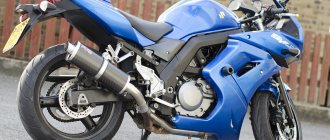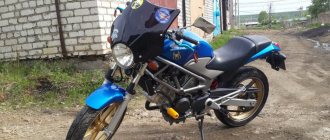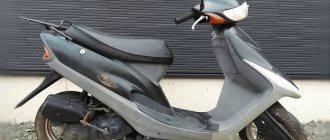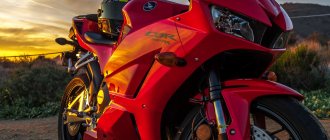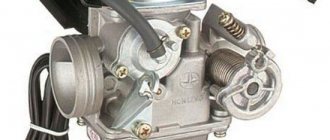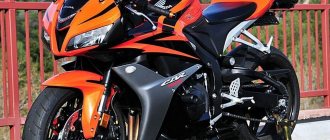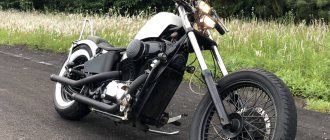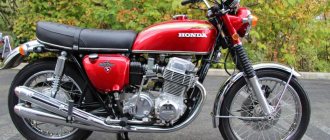At the beginning of the 21st century, Honda begins updating and gradually replacing the XR line . It should be replaced by a more modern, progressive CRF line. An important feature is that the update should not affect the change in motorcycle classes. In the old line there is a cross - it should be in the new one, there is an enduro - you need to collect an enduro based on the new line.
Of course, it is advisable to leave the engine size the same. Not every user will agree to change a bike with 250 cc to a progressive, but more power-hungry model with 300, 350 cc.
Thus was born the line of motorcycles Honda CRF 450 and the “ cheka ” - the younger sister of the Honda CRF 250 . And if the older model immediately had three modifications (X, R, F), then the 250 cc bike was presented in only 2 variations;
- Honda CRF 250 X - enduro ;
- Honda CRF 250 R - cross .
The release continues.
Construction of HONDA CRF 250
The main innovations highlighted by the CRF series include two:
- Due to the use aluminum alloys when creating the frame — the bike should become lighter. Accordingly, it handles better, turns easier, and behaves better in various road conditions.
The CRF 250 series received a reinforced aluminum frame in 2011 along with new suspension settings.
- Installed on bikes water cooling, since experiments have shown that a standard air system may sometimes not be enough.
The radiator of the cooling system is covered on the side with a plastic fairing.
Although the 250 cc modifications were developed in parallel, the developers nevertheless ended up with two separate motorcycles . They have related features, but at the same time there are differences.
Peculiarities
Both versions get upside-down telescopic front forks.
The inverted Showa fork looks serious and does not cause any particular complaints in operation.
But, if the enduro bike has a metal thickness of the stays of 47 mm , with a working stroke of 315 mm , then the cross-country model has these parameters of 49 and 310 mm, respectively. There is a difference in the rear as well.
The general design is with a mono-shock absorber , but at the same time, the enduro has a useful stroke of 315 mm , and the cross-country bike has 310 . The settings options are the same. For both models, the user can adjust the entire range of parameters.
To change the parameters of the rear suspension, use a compressed air cylinder.
Exterior
There are also minor changes in the external design of the models.
In stock, both have the brand's signature red and white livery, but the enduro version is constantly receiving new additions and colors.
Streamlined shapes and clean lines - the bike as a whole looks impressive.
Front end
- If the older sister's main difference here is the headlight or plate with the number, in the 250 cc the developers did something different. The cross version has a standard front part - a complete lack of body kit, leaving only space for a license plate.
Honda CRF 250 X - enduro with headlight.
Honda CRF 250 R – cross with a nameplate.
- The enduro has a symbolic front body kit , in the lower part of which a headlight . In 2011, the developers revised the electrical system. The result was the replacement of the stationary one with LED.
- Otherwise, the front of the bikes is identical. Large, high-raised front fender, lack of mirrors and windshield .
Rear end
The back of the bike is “clean” of any lighting equipment.
Interestingly, many stock models also have a saddle painted in the brand’s colors. But at the same time, the fuel tank cover, located in a standard place, is the only part of the bike painted black.
A cross bike has a 6.5 liter capacity, while an enduro bike has 7.5 liters. According to users, a full refueling capacity holds 7.3 liters.
The stock gas tank is painted black.
Another feature of the enduro version is the presence of two exhaust pipes that work “in sync” . The developers do not comment on the need for such a step.
The photo shows the option with two mufflers.
The remaining details of the versions are the same and fully comply with class standards.
A narrow frame, a symbolic saddle, and the presence of high pegs allow you to overcome certain problems of the track while standing.
Surprisingly, the seat will be comfortable even for a tall rider, and the seating position is closer to road than off-road.
Modifications and production history
Honda CRF250 is available in 4 specifications:
- CRF 250 X – enduro version;
- CRF 250 R – cross-country version;
- CRF 250L and CRF 250M are budget models for untrained pilots.
As already mentioned, the history of the production of devices began in 2000. Over such a long period, they would inevitably become outdated if not for periodic modernizations. Initially, all versions were produced with a carburetor power system. Since 2010, the Honda CRF 250R modification has received a PGM-Fi injection system with control electronics. Since 2011, the Honda CRF 250 begins to be equipped with a reinforced aluminum frame and updated suspensions. The CRF 250 X modification receives LED optics based on LED elements.
Honda CRF 250
Specifications
Despite the fact that the engine capacity of both versions is the same, the power is different. At the same time, the difference in the issued “horses” varies by almost one and a half times.
You can be confident in the reliability of Honda engines, especially if it is a motor for a motocross motorcycle.
For a motocross motorcycle, different, forced settings are used, but the engine remains alone. This is a 1-cylinder 4-stroke engine (the first value is for cross-country, the second for enduro);
- working volume - 248 cm3;
- power - 43.30 hp;
- number of valves - 4;
- diameter - 30, 31;
- cylinders - 1;
- cooling - liquid;
- fuel supply - injector (since 2010), carburetor;
In recent years, the engine has undergone several changes - torque at low speeds has been increased, and a mode change button has appeared on the R model.
- ignition - transistor, electronic;
- start - kick starter, electric starter;
- fuel tank - 6.5 and 7.3 l.
Starting the engine did not have strict regulations. Enduro could only have a foot, while racing could only have a button and vice versa. There were versions with two working options.
Transmission and clutch
The bikes have a 5-speed gearbox. There are no special settings depending on the model.
But users note that if the bike is destined for a sporting destiny, it is better to immediately replace the gearbox with a tuned one that shifts more clearly and has less free play. In contrast, owners of enduro versions notice that the factory gearbox works quite normally, the gear ratios are selected within reasonable limits, and there is no need to apply any new solutions to it - “ it works and don’t touch it .”
The clutch cover bears the Honda inscription.
- The clutch in both versions follows the same principle - multi-disc , using an oil bath.
- Drive - chain .
Chain catcher.
Tension roller.
Chain lock.
Brakes
Both models have 1-disc hydraulic brakes. The difference is insignificant - only in the diameter of the front disc.
Therefore, only the settings of the enduro model will be given below. The cross's front disc is 20 mm wider .
The front brake disc is covered with a plastic lining, carefully made and neatly fitted.
Front brakes:
- number of disks - 1;
- diameter - 240 mm;
- support - 2-piston.
Rear brakes:
- number of disks - 1;
- diameter - 240 mm;
- support - 1-piston.
No options provided.
Dimensions and weight
The curb weight of the enduro bike was 115 kg. Version R (cross) is 10 kg less.
The Honda turned out to be quite light compared to its competitors.
The overall dimensions are also slightly different (the first parameter is enduro, the second is cross):
- in length - 2181, 2174 mm;
- width - 827, 827 mm;.
- Height - 1271, 1261 mm, square saddle - 961, 958 mm.
- Ground clearance - 322, 340 mm.
MY MOTORCYCLE
Many lovers of speed and connoisseurs of freedom prefer a motorcycle, because a bike is a universal means of transportation that allows you to get anywhere. It was for people like them that a special series of Dual Sport or dual-purpose motorcycles was created. In fact, these are two-wheeled analogues of SUVs that can crawl through such jungles that the owners of some bikes are afraid to even imagine.
The main competitors in this class of motorcycles are Honda, Kawasaki and Yamaha; each company offers customers its own version of the Dual Sport bike in the category of four-stroke “quarters”, which differ little from each other in their features and price. However, manufacturers do not stand still and are trying to make their models more and more advanced. Honda was one of the last to update its dual-purpose bike, which can easily conquer asphalt and off-road.
The Honda CRF250L easily overcomes dirt roads or domestic off-road conditions. Many people use this “multi-purpose” motorcycle for long journeys.
Just take one look at the Honda CRF250L and you'll immediately notice how impressive it looks. The motorcycle has a streamlined shape and clear lines. Particularly striking is the engine and the method by which the engineers hid all the wires and pipes. This Honda looks much more expensive than it actually costs. At the same time, they did not skimp on the motorcycle - it is made of very high quality materials. The CRF has a low seat height of 88 cm, which is 2.5 cm less than the Kawasaki and 5 cm less than the Yamaha WR. This will be good news for those who are short in stature. However, those who are taller than 180 centimeters will find it difficult to stand up on the footrests when riding off-road - the handlebars of the motorcycle are located at the ideal level for riding while sitting, by the way, and the seat on it is quite comfortable.
When measuring the parameters, it turned out that the Honda has the heaviest weight compared to its competitors - 145 kg, although this is not felt while driving. This is thanks to the responsive and reliable engine, which starts instantly in any conditions by pressing the starter button. The engine has direct fuel injection and there are no problems with its operation, even when the street is below zero. The powerful power unit, together with a very sensitive clutch, makes it clear that the vehicle is not created for entertainment. The gauges are easy to read, especially the fuel gauge, something neither Kawasaki nor Yamaha can boast of.
When driving on the road, the CRF behaves perfectly. The motorcycle accelerates to hundreds faster than its competitors - in just 8.6 seconds, however, with such dynamics, the engine is quite responsive when compared with similar models with an engine capacity of 250 cm3. Riders who like to listen closely to the exhaust note will appreciate its subdued tonality. At idle, the volume of the muffler is 72 dB, while driving - from 86 dB.
The power unit of the Honda CRF250L is borrowed from the sports CBR250R, although for off-road driving the designers had to slightly deboost it and “tighten up” the torque.
When measuring the revolutions, it turned out that the torque of the Honda CRF250L is higher than that of the Kawasaki motorcycle - 18.43 Nm, but this is less when compared with the WR. The maximum engine power can be squeezed out already at the bottom. This is why Honda has much more flexibility than others. If we compare horsepower, then its number is the same as that of the KLX, but 25% less than that of the Yamaha.
It is not surprising that having the heaviest weight and not the most impressive reserve of heads in the herd of horsepower, the Honda CRF250L runs a distance of 400 meters slower than its competitors - in 19.64 seconds, while accelerating to 121 km/h. But this had a beneficial effect on fuel consumption. The owner of a Honda CRF250L will need only 1 liter per 27 km, that is, once you fully fill the tank, you can travel a distance of 200 km. Some people will like this efficiency, but for many people who like to drive off-road, this is not a plus.
Excellent stopping power is provided by wavy disc brakes. The model is equipped with all the necessary lighting equipment to drive on roads intended for public use.
Many bikers will appreciate the smooth power delivered throughout the engine's entire operating range. On the road the bike behaves very well, but it also has some disadvantages, for example, the lack of “jerk”, so for those who like to ride with the front wheel jumping over obstacles, this will be a big problem. An excessively long second gear is also not conducive to active driving. You will often have to make a choice - leave the motorcycle running in second and put up with the roar of the engine, or strain to climb the hills and taxi through the mud in third.
Another detail that may influence the decision not to ride the Honda CRF250L in the mud is that the motorcycle’s suspension is not performing well. The front wheels carry less than 30 percent of the weight when the biker is in the saddle, so at certain moments, in order to steer, you have to lean towards the handlebars and thus try to maintain balance and at the same time give the front wheel momentum for better traction. This problem cannot be solved even by adjusting the shock absorbers, which, by the way, are quite difficult to adjust, since for some reason the necessary keys are not included in the standard set of tools for a motorcycle.
The front brake mechanism also does not work well. It is not very informative when you squeeze the lever, so the driver may have difficulty controlling the motorcycle on rocks and various uneven surfaces. However, with all this, it demonstrated amazing efficiency when braking on asphalt surfaces from a speed of 100 km/h to 0. The braking distance was only 37 meters, this figure is one meter less than the WR and slightly more when compared with the Kawasaki. The rear brake works perfectly for a motorcycle of this class.
Apparently, the Honda CRF250L is primarily intended for beginners. Although the engine is very smooth, it does not have the wildness that people buy motorcycles for. However, normal driving around the city and the safety of the motorcyclist on this vehicle are quite possible. Therefore, Honda’s attempt to gain new fans can be considered successful.
Honda CRF250L, technical specifications:
| Motor and drive | |
| engine's type | Single cylinder |
| Number of cycles | 2 |
| Volume | 250.00 cm³ |
| Diameter*Stroke | 76.0 mm x 55.0 mm |
| Valves per cylinder | 4 |
| Compression ratio | 10.7:1 |
| Power | 25.30 l. With. @ 9500 rpm |
| Torque | 18.70 Nm @ 7000 rpm |
| Fuel system | Fuel injection |
| Cooling system | Liquid cooling |
| Ignition | Electronic ignition |
| Fuel control | DOHC |
| Clutch | Multi-disc, oil bath |
| Transmission | 6-speed |
| Drive unit | Chain |
| Fuel consumption | 5.50 l/100km |
| Maximum speed | 140.0 km/h |
| Chassis | |
| Frame | Tubular. Steel |
| Front suspension | 43 mm Inverted type. Customizable |
| Front suspension travel | 250 mm |
| Rear suspension | Pendulum. Monoshock absorber. Pro-Link |
| Rear suspension travel | 240 mm |
| Fork angle | 27.6° |
| Discs | Spoke |
| Front wheel size | 3.00–21 |
| Rear wheel size | 120/80-18 |
| Front brake | Disk, 1 disk |
| Front brake diameter | 256 mm |
| Rear brake | Disk, 1 disk |
| Rear brake diameter | 220 mm |
| Weight and dimensions characteristics | |
| Length | 2195 mm |
| Width | 815 mm |
| Height | 1195 mm |
| Seat height | 875 mm |
| Minimum ground clearance | 255 mm |
| Wheelbase | 1445 mm |
| Curb weight | 144.0 kg |
| Power/weight ratio | 0.1757 |
| Gas tank capacity | 7.7 l |
Driving performance
Acceleration to 100 km is 5 seconds. The measurements were carried out under factory conditions.
According to users, 95 is reached even faster, but the bike simply does not want to accelerate further.
Maximum speed
The maximum speed declared by the developers is 100 km/h . According to users, with the correct settings, the cross version can reach 150 km/h. True, the headwind interferes greatly.
Fuel consumption
Fuel consumption depends on road conditions, but with the right settings it does not rise above 4.5 liters. per 100 km .
dimensions
Models TsRF 250 X and TsRF 250 R have the following overall dimensions:
- length – 2174 mm;
- width – 827 mm;
- handlebar height – 1261 mm;
- wheelbase – 1481 mm;
- saddle height – 958 mm;
- ground clearance - 346 mm;
- The departure angle of the front fork is 27.50.
Honda CRF 250
Modifications (CRF250L, CRF250M, CRF250L Rally)
In addition to those described on the Internet, there are references to three more modifications.
- Honda CRF250L - an enduro motorcycle that has common features with the development of the plant CBR250. Deformed engine, complete absence of any settings for the suspension, at least some innovations, steel frame.
It’s better not to go into such jungle on a lightweight version, and Honda itself classifies the L-ku as a dual-purpose bike, and not as an uncompromising “dirt mixer”.
- Honda CRF250M assembled on the basis of the previous one, full compliance with technical characteristics, road tires and wheels of the same diameter classify it as a motard.
Already from its appearance it is noticeable that the M is more oriented towards road use.
- Honda CRF250L Rally is the next stage of development of the L model. Increased height, ground clearance, larger brake discs and stock ABS for European markets.
Apart from the same engine capacity - 248 cm3, there are no other common parts. The first two models were presented by the concern for budget users in 2012.
If we compare in numbers, budget models initially lag behind the R and X versions, which the developers position as the flagships of the line.
Users note that these budget versions have one big advantage - an almost ideal weight distribution of 46/54% , which makes riding such a bike no more difficult than a bicycle ride.
Flaws
- Difficult to maintain.
- It's not easy to catch neutral.
- You need to get used to the sensitive reaction to the movement of the gas/brake handles.
Advantages
- Dynamism and traction.
- Checkpoint.
- Maneuverability.
- Lightweight and manageable.
Hi, gang! Long time no see, and in the meantime the series on finding the ideal (for me) motorcycle continues. In previous episodes, buying a necrocruiser, wrapping a necrocruiser on a curb, restoring and buying a tourenduro, falling from grace to a Chinese enduro. Spinoffs with Soviet and American equipment.
How long or how long did it take me to get rid of the TA650 and the 200cc Chinese Zongsheng and, on the advice of friends, decided to buy a Honda CRF250L motorcycle! New model! Straight from the salon.
I have driven about 4000 km since purchase. Good things:
1. Cool stock tires. A good saber that goes both on soil and asphalt. 2. The motorcycle is tailed - there is room for a tuning trunk on which you can throw a shmurdyak and there will be room for a passenger.
3. Resource. The engine is heavily throttled. The service interval according to the book is 12,000 km. 4. Bright appearance - dids willingly share stories about IZhi and Java. This was last seen on Drage and passed TA and Zongshen. 5. Consumption. 6. Strong plastic. I drop every exit until only the decorative trim above the outlet has given up. 7. There is a glove compartment with space for tools. 8. Power step. It is convenient to lift the motorcycle to wash the chain.
I know you're not here for the positives, so here's what's really annoying:
1. Not enough space. This is my problem, height 190, in short it was cramped both on TA and on Drage.
2. Your ass gets numb when you drive on asphalt. Well, really. The saddle is like the engineers at Honda really thought that not kids would go fishing on these bikes, but teenagers would conquer the Dakar. You ride on the ground - everything is great, you work with the motorcycle, you give the 5th point a rest. You drive onto the asphalt - 15 minutes and that’s it, bummer.
It’s clear that the Hindu enthusiasts will object, why are you driving on it on asphalt, to which I will object that after an active day on the dirt, I somehow want to get home in an hour, and it’s often easier to get to beautiful places with asphalt. In short, this is a serious minus and people are fighting it by replacing saddles and other dances with tambourines. 3. Exhaust sound. I have a vacuum cleaner at home that drives itself, it sounds a little louder and more aggressive than the stock SRF. There’s nothing bad about it, when you ride all day long it’s a plus, but kamon, after all, a motorcycle is a thing for emotions. This is solved by tuning the intake and exhaust. Of course, I will have time to get to this collective farm. 4. Soft suspension - a controversial point, but sometimes it infuriates. 5. ABS wires that cover the entire panel. You can see them above the windshield when you drive only them and see them instead of the panel.
6. The motorcycle wakes up after 6000 rpm. 1st, 2nd and 3rd gears are short, respectively; the torque window, which opens quite late, causes inconvenience in sand and mud. 7. Narrow grips for small Japanese hands.
In general, I am with this motorcycle for a long time - it will live with me in the pragmatic format of dual sport trips. It's far from perfect, but it doesn't have to be)
The search for the dream continues) I can recommend it to settled endurists)
conclusions
Currently, the Honda CRF 250 in flagship versions is one of the leaders among the huge variety of enduro-cross motorcycles.
The sensitive reaction of the motorcycle to the movements of the gas/brake handles can cause problems for an inexperienced user at first. But at the same time, both types of bikes imply that a person who already understands a lot about motorcycles will sit behind the wheel.
For enduro lovers, the Honda CRF 250 will be a real gift , allowing you to climb where even an SUV gets stuck without any problems or questions.
Various additional equipment is available for bikes of this series, for example, protection of the exhaust manifold and engine.
Technical description
Both modifications 250 X and 250 R are equipped with the same 1-cylinder 249 cc water-cooled engines. Start - electric starter. They differ in compression ratio, power, ignition and power systems.
The Honda CRF 250 X motorcycle has a combustion chamber with a compression ratio of 13.5. Develops a maximum power of 43.7 hp. With. at 11 thousand rpm. The highest torque of 25 Nm is achieved at 8 thousand rpm. The injection system is injection, with control electronics. Ignition is transistorized.
The Honda CRF250R has a lower compression ratio of 12.9 and a correspondingly lower power output of 30 hp. With. at 9 thousand rpm. The fuel delivery system uses a Keihin carburetor with throttle position sensor and 37mm jets. Electronically controlled ignition CDi.
Gearboxes are only mechanical, with 5 steps. Torque is transmitted to the rear wheel by a chain. Aluminum frame, extruded (injection molding technology).
Motorcycle performance ratings
Both models, according to owners' reviews, provide good technical characteristics in comparison with competitors, have high off-road qualities and are comfortable enough for long driving.
Honda engines are famous for their high power density, low noise (89.9 dB - high for motocross bikes), reliability and durability. Starting the engine using an electric starter is very convenient.
There are also disadvantages. Despite the fact that the electronic injection engine accelerates excellently on short stretches, it behaves mediocrely on long stretches. The power is excellent at medium speeds, not bad at low speeds, but at the top the engine smokes and roars more. The problem is that the standard muffler suffocates the engine too much. The use of a tuning exhaust improves power at the top, but there is no trace of low noise.
Carburetor versions suffer from failures when opening the gas, which does not provide the necessary pickup when exiting turns and landing after jumps. But with a highly skilled approach with the right needle and set of jets, it is still possible to achieve a clear response to the gas.
Thanks to the use of electronic injection on the CRF 250 X, the ignition circuits can be changed simply by reprogramming the control module. This is a modern analogy to replacing jets in carburetors.
The frames have also proven to be highly wear-resistant and sufficiently rigid. The use of aluminum alloy in their design made it possible to reduce the overall weight of the motorcycle. Due to the use of a front fork with insufficient lean angle, the motorcycle suffers from oversteer when entering corners. This manifests itself in the fact that the steering wheel tends to escape from your hands when entering a turn, and on straight sections there is a need to constantly adjust the trajectory. The deficiency is cured by installing a rear pendulum of an extended design.
For all heavier riders (over 75kg), it is recommended to change the fork springs to stiffer ones to prevent the front wheel from diving under braking.
Honda CRF 250
Post Views: 23,362

